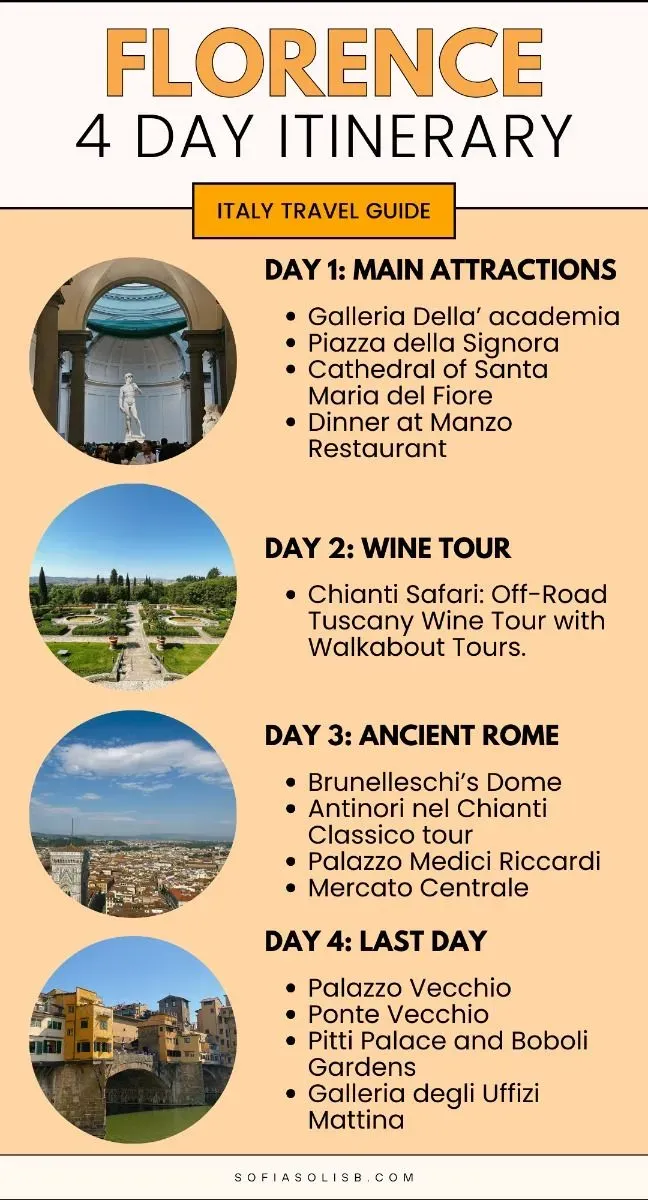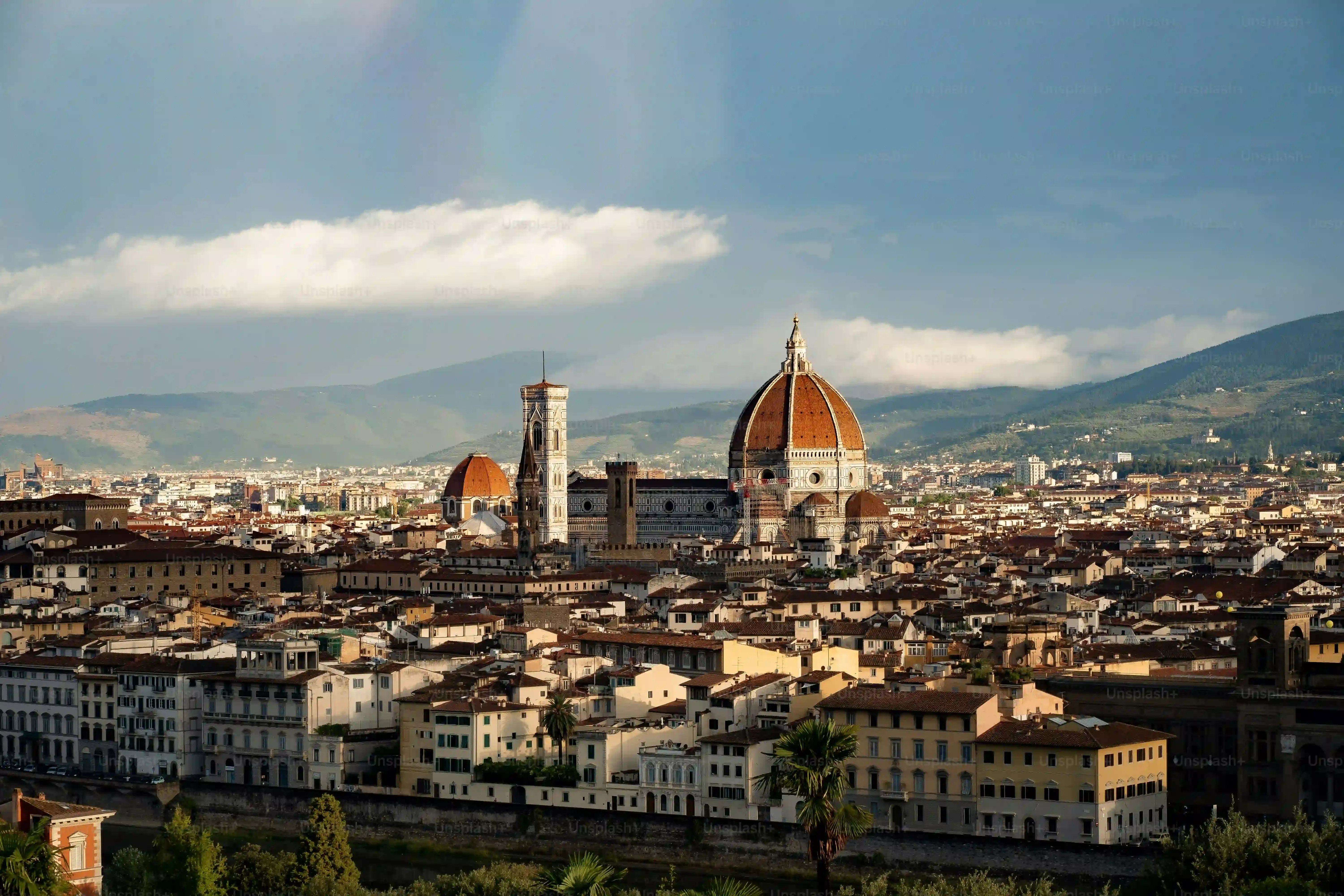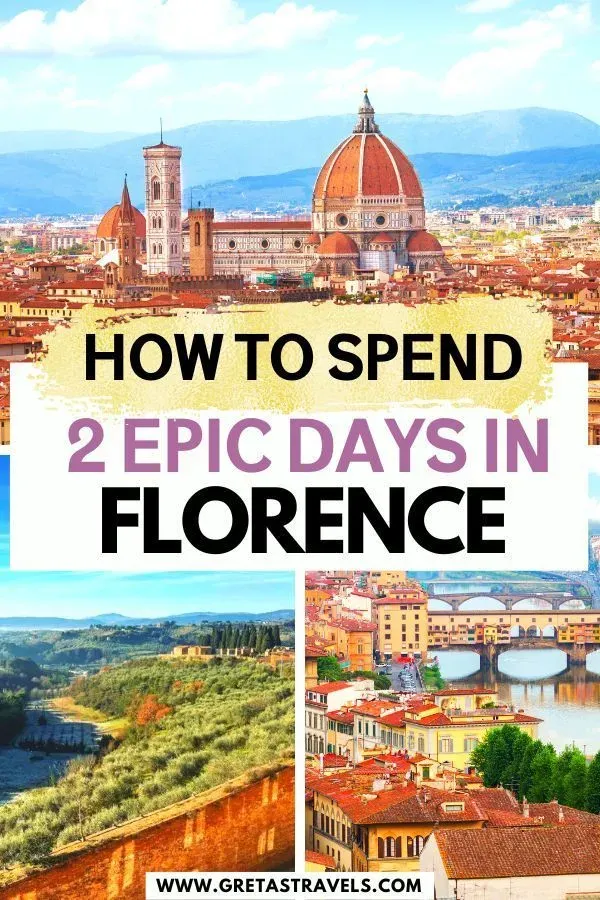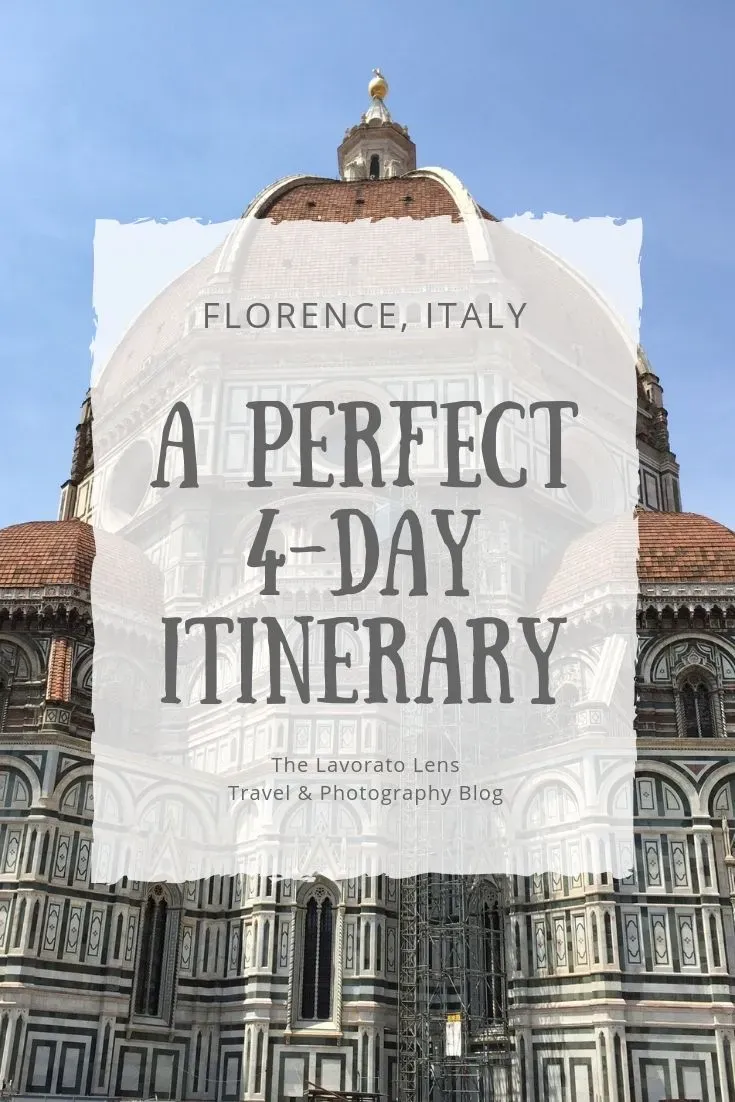Table of Contents
Standing in Florence, surrounded by centuries of art and history, can feel overwhelming. The sheer density of masterpieces, the winding alleys whispering tales of the Medici, the aroma of leather and espresso – it hits you all at once. You’ve got a precious window of time, maybe just a few days, and the pressure is on to soak it all in without feeling like you’re just ticking boxes. Forget the rushed, superficial dash. This isn't about sprinting from one selfie spot to the next, ending up exhausted and feeling like you missed the soul of the place. Crafting a solid plan is the difference between a whirlwind of stress and a truly memorable journey through the cradle of the Renaissance.
Planning Your Perfect 4 Day Itinerary Florence Italy

Planning Your Perfect 4 Day Itinerary Florence Italy
Alright, so you've decided on Florence for four days. Excellent choice, but let's be real – everyone else thinks so too. Just showing up and hoping for the best? That's a recipe for spending half your time in lines and missing the truly good stuff. Successfully tackling a isn't just about listing museums; it's strategic warfare against crowds and fatigue. You need a game plan that respects the fact that your feet will hurt, gelato breaks are mandatory, and standing nose-to-armpit with strangers to see a painting loses its charm fast. Think of it less like a rigid schedule and more like a smart framework – hitting the big names early or late, grouping sights geographically so you're not crisscrossing the Arno like a confused pigeon, and crucially, building in downtime. Because nobody enjoys a vacation that feels like a forced march through history.
Day 1: Arrival and Renaissance Heartbeat

Day 1: Arrival and Renaissance Heartbeat
Touching Down and Feeling the Weight of History
So you've landed, navigated the airport (hopefully without too much drama), and somehow made it into the city proper. The air feels different here, heavier with history, maybe a little chaotic depending on the time of day. Welcome to your . Your first order of business, after ditching your luggage somewhere secure, is simply to step outside and breathe it in. Walk towards the historical center. You don't need a map for this first sensory overload; just follow the flow, the narrowing streets, the sudden glimpses of terracotta roofs and imposing stone facades. That feeling? That's the Renaissance tapping you on the shoulder. It’s less a gentle nudge and more a firm reminder that you're treading ground where giants once walked, debated, and, yes, probably complained about the heat.
Trying to see everything the moment you arrive is a rookie mistake. You're tired, probably a bit disoriented, and Florence doesn't reveal its secrets to the hurried. Instead, focus on getting your bearings and letting the atmosphere wash over you. Grab an espresso standing at a bar like the locals do – it's cheaper and faster. Wander towards the Duomo area, even if you're not going inside yet. Just seeing that massive dome dominate the skyline for the first time is the required initiation into Florence. It’s a "Yep, I'm actually here" moment that hits harder than any postcard.
- Locate your accommodation and drop bags.
- Grab a quick, standing espresso.
- Walk towards the Duomo complex (exterior view).
- Note the general layout of the core historical center.
- Resist the urge to buy the first leather bag you see.
The Duomo's Grand Introduction
Alright, time to face the music, or rather, the marble. The Cattedrale di Santa Maria del Fiore, Brunelleschi's Dome, Giotto's Campanile, and the Baptistery – this cluster is the undeniable heart of Florence, and tackling it on Day 1 makes sense. Stand in the piazza and just look up. The sheer scale is frankly ridiculous. How did they even build that dome without modern cranes? It’s a marvel of human ingenuity and stubbornness. Getting tickets to climb the Dome or Giotto's Tower requires booking way ahead, so assume you’ve done that. The climb is steep, narrow, and involves squeezing past other sweaty tourists, but the view from the top? Absolutely worth the questionable life choices you made getting up there.
Inside the Duomo itself can feel a bit bare after the exterior spectacle, but the frescoes on the dome's interior are something else. The Baptistery doors, particularly Ghiberti's Gates of Paradise (the copies, the originals are in the Duomo Museum), are stunning examples of Renaissance bronze work. Don't just rush through; look at the details. Imagine the artists hunched over these panels for years. This entire complex is a masterclass in Renaissance ambition, a physical manifestation of Florence's belief in itself as the center of the universe. It's a heavy start, but essential to grounding your entire visit.
Day 2: Art, Palaces, and Riverside Strolls

Day 2: Art, Palaces, and Riverside Strolls
Facing the Masters: The Uffizi Wake-Up Call
Day 1 was the warm-up act, getting acquainted with Florence's imposing presence. Now comes the main event for many: the art. Your is likely going to involve some serious gallery time, and there's no better place to start than the Uffizi Gallery. Let's be clear, this isn't a casual wander. This is a pilgrimage through some of the most important paintings ever created. Botticelli's "Birth of Venus," Leonardo's "Annunciation," Caravaggio's "Medusa" (the shield version, naturally) – they're all here, usually surrounded by a throng of people vying for the perfect photo. Booking tickets months ahead is not optional; it’s survival. Walk in expecting crowds, but focus on the art itself. Find a quiet corner, ignore the selfie sticks for a moment, and just look at the brushstrokes, the colors, the sheer audacity of these works. It’s easy to feel overwhelmed, but pick a few pieces that resonate and spend some time with them. You don't need to see everything to appreciate the magnitude of what's on display.
Day 3: Medici Legacies and Panoramic Views

Day 3: Medici Legacies and Panoramic Views
Palazzo Pitti and Beyond the Arno
Day 1 was the Duomo shock, Day 2 was the Uffizi deep dive. Now, for , we're crossing the river. Literally. Head over the Ponte Vecchio – try to do it early before it's completely gridlocked with souvenir hawkers and tourists taking identical photos. Your destination? The Oltrarno district, specifically Palazzo Pitti. This isn't just another palace; it's a sprawling complex the Medici snagged when they outgrew their earlier digs (Palazzo Vecchio, which you might have seen already). Think of it as their mega-mansion, stuffed with art collections and leading into vast gardens. It’s easy to spend half a day here just wandering through the various galleries – the Palatine Gallery with its Raphael and Titian is the main draw – and trying to imagine the sheer wealth and power required to fill these rooms.
Beyond the palace walls, the Oltrarno has a different vibe than the historical core. It’s traditionally the artisan quarter, where workshops still hum with activity. You’ll find leather workers, restorers, and artists. It feels a bit more lived-in, less like a museum exhibit and more like a working city. Take some time to explore the smaller streets, peek into courtyards, and maybe find a trattoria that isn't plastered all over Instagram. This is where you might actually bump into Florentines doing Florentine things.
Wandering the Boboli Gardens
Emerging from the grandeur of Palazzo Pitti, you step into the Boboli Gardens. Now, these aren't your manicured English gardens. These are Italian Renaissance gardens, meaning they're designed to impress, full of statues, fountains, grottos, and elaborate landscaping. It's a workout, frankly, with hills and stairs, but it offers a much-needed green escape from the stone and marble of the city. Find the Neptune fountain, the Isolotto (an island in a pond), and just wander the paths. It’s easy to get a little lost, which is part of the fun. Plus, as you climb higher, you start getting glimpses of the city skyline peeking through the trees.
The gardens are a direct reflection of the Medici's desire to create a private pleasure ground and a symbol of their power and taste. They hosted lavish parties and theatrical performances here. Walking through, you can almost hear the echoes of rustling silk and polite (or not-so-polite) gossip. It’s a different kind of history lesson than the art galleries, one about leisure, landscape design, and the sheer extravagance of the ruling class.
Thinking about the Medici's influence on Florence, it's staggering. What's one thing you've learned about them that surprised you?
Sunset from Piazzale Michelangelo
No in Florence is complete without the pilgrimage to Piazzale Michelangelo for sunset. Yes, it's packed. Yes, you will be shoulder-to-shoulder with hundreds of other people, many of whom are also holding cameras or phones aloft. But there's a reason for the crowd: the view is simply breathtaking. As the sun dips below the horizon, casting a golden light over the Arno and illuminating the Duomo, Palazzo Vecchio, and the bridges, it’s one of those moments that actually lives up to the hype. It’s the postcard view, the iconic shot, and standing there, seeing the city laid out before you, provides perspective on everything you've seen over the past few days.
Getting up there requires a bit of a climb (or a bus/taxi ride, no judgment). Find a spot early if you want a prime viewing location. There are vendors selling drinks and snacks. Just sit back, watch the light change, and appreciate the cumulative effect of Florence's beauty. It’s a perfect way to cap off a day immersed in Medici history and art, offering a sweeping visual summary of the city they shaped.
Day 4: Last Bites and Departure Tips

Day 4: Last Bites and Departure Tips
Savoring the Final Florentine Morning
Your incredible 4 day itinerary Florence Italy is winding down. That bittersweet feeling hits – you're tired, your feet ache, but you're already dreading leaving. This final morning isn't about cramming in one last major museum. It's about cementing the memories. Head back to a piazza you loved, maybe Piazza della Signoria or a quieter neighborhood square. Grab a final cornetto and cappuccino at a pasticceria. Don't just stand at the bar; find a small table, sit down, and watch the city wake up. Maybe pick up those last-minute edible souvenirs – a bottle of olive oil, some cantucci, a small block of parmesan. Avoid the tourist traps near the Duomo for this; find a local alimentari or market. It's about experiencing the everyday rhythm one last time before you head for the exit.
The Practicalities of Saying Arrivederci
reality bites. It's time to actually leave. Getting out of Florence, especially with luggage, requires a plan that doesn't involve panicked sprinting through cobbled streets. If you're flying, factor in the time to get to Florence Airport (FLR). A taxi is easiest but pricier; the Volainbus shuttle from the main train station (Santa Maria Novella) is a solid, cheaper alternative. If you're taking a train to another city, navigating the station is straightforward, but give yourself ample time, especially if you need to validate tickets or find your platform. Double-check your flight or train times. Make sure you know exactly how to get from your accommodation to your departure point. The romance of Italy fades fast when you're dragging a heavy suitcase and realizing you missed the last bus.
- Confirm flight or train departure times.
- Plan your transport to the airport or train station in advance.
- Allow ample time for travel and check-in/security.
- Check if you need to validate your train ticket before boarding.
- Ensure all your belongings are packed (check under the bed!).
- Have your passport/ID and tickets readily accessible.
- Consider buying final snacks or water for the journey.
Making Your 4 Day Florence Itinerary Stick
So, you've navigated the Uffizi crowds, perhaps braved the Duomo climb, and hopefully found a few quiet corners away from the main tourist drag. Four days in Florence is a solid block of time, enough to get a real taste, but let's be honest, it's just scratching the surface. You've seen the heavy hitters, maybe discovered a favorite gelato spot, and perhaps even started to distinguish between the countless depictions of the Madonna and Child. It's a city that demands tough choices and requires you to accept you won't see everything. But if you followed a plan, even loosely, you avoided the aimless wandering that plagues many first-timers. You got a feel for the place. Now, the real test is how long that feeling lasts once you're back home and the only Renaissance art in sight is on a refrigerator magnet.
